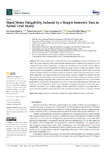Mostrar o rexistro simple do ítem
Hand motor fatigability induced by a simple isometric task in spinal cord injury
| dc.contributor.author | Onate-Figuérez, Ana | |
| dc.contributor.author | Soto-León, Vanesa | |
| dc.contributor.author | Avendaño-Coy, Alejandro | |
| dc.contributor.author | Mordillo-Mateos, Laura | |
| dc.contributor.author | Pérez-Borrego, Yolanda A. | |
| dc.contributor.author | Redondo-Galán, Carolina | |
| dc.contributor.author | Arias, Pablo | |
| dc.contributor.author | Oliviero, Antonio | |
| dc.date.accessioned | 2022-09-26T09:26:45Z | |
| dc.date.available | 2022-09-26T09:26:45Z | |
| dc.date.issued | 2022-08-30 | |
| dc.identifier.citation | Onate-Figuérez A, Soto-León V, Avendaño-Coy J, Mordillo-Mateos L, Pérez-Borrego YA, Redondo-Galán C, Arias P, Oliviero A. Hand Motor Fatigability Induced by a Simple Isometric Task in Spinal Cord Injury. J Clin Med. 2022 Aug 30;11(17):5108. | es_ES |
| dc.identifier.issn | 2077-0383 | |
| dc.identifier.uri | http://hdl.handle.net/2183/31728 | |
| dc.description.abstract | [Abstract] This study aimed: (1) to evaluate the hand motor fatigability in people with spinal cord injury (SCI) and compare it with measurements obtained form an able-bodied population; (2) to compare the hand motor fatigability in people with tetraplegia and in people with paraplegia; and (3) to analyse if motor fatigability is different in people with SCI with and without clinical significant perceived fatigability. Materials and methods: 96 participants with SCI (40 cervical and 56 thoracolumbar) and 63 able-bodied controls performed a simple hand isometric task to assess motor fatigability. The Fatigue Severity Scale was used for perceived fatigability evaluation. Results: The main results of this study can be summarized as follows: (1) the waning in muscle force (motor fatigability) during a fatiguing task is similar in controls and participants with SCI; (2) the motor fatigability is influenced by the maximal muscle force (measured at the beginning of the task); and (3) the perceived fatigability and the motor fatigability are largely independent in the individuals with SCI. Conclusion: Our findings suggest that the capability to maintain a prolonged effort is preserved in SCI, and this capacity depends on the residual maximal muscle force in people with SCI. | es_ES |
| dc.description.sponsorship | Project ICI20/00075, funded by Instituto de Salud Carlos III (ISCIII) and cofounded by the European Union. | es_ES |
| dc.description.sponsorship | info:eu-repo/grantAgreement/ISCIII/Programa Estatal de Generación de Conocimiento y Fortalecimiento del Sistema Español de I+D+I/ICI20%2F00075/ES/EL RIMONABANT PARA LA MEJORA DE LA CAPACIDAD DE ANDAR EN LESIONADOS MEDULARES | |
| dc.language.iso | eng | es_ES |
| dc.publisher | MDPI | es_ES |
| dc.relation.uri | https://doi.org/10.3390/jcm11175108 | es_ES |
| dc.rights | Creative Commons Attribution 4.0 International License 4.0 (CC-BY 4.0) | es_ES |
| dc.rights.uri | http://creativecommons.org/licenses/by/4.0/ | * |
| dc.subject | Fatigue | es_ES |
| dc.subject | Fatigue severity scale | es_ES |
| dc.subject | Human | es_ES |
| dc.subject | Isometric contractions | es_ES |
| dc.subject | Spinal cord injury | es_ES |
| dc.title | Hand motor fatigability induced by a simple isometric task in spinal cord injury | es_ES |
| dc.type | info:eu-repo/semantics/article | es_ES |
| dc.rights.access | info:eu-repo/semantics/openAccess | es_ES |
| UDC.journalTitle | Journal of Clinical Medicine | es_ES |
| UDC.volume | 11 | es_ES |
| UDC.issue | 17 | es_ES |
| UDC.startPage | 5108 | es_ES |
Ficheiros no ítem
Este ítem aparece na(s) seguinte(s) colección(s)
-
GI-NEURO - Artigos [158]






